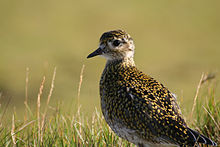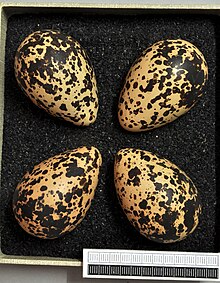European golden plover
| European golden plover | |
|---|---|
 | |
| Adult in breeding plumage | |
Conservation status | |
 Least Concern (IUCN 3.1)[1] | |
Scientific classification | |
| Kingdom: | Animalia |
| Phylum: | Chordata |
| Class: | Aves |
| Order: | Charadriiformes |
| Family: | Charadriidae |
| Genus: | Pluvialis |
| Species: | P. apricaria |
Binomial name | |
Pluvialis apricaria (Linnaeus, 1758) | |
 | |
Synonyms | |
| |
The European golden plover (Pluvialis apricaria), also known as the Eurasian golden plover or just the golden plover within Europe, is a largish plover. This species is similar to two other golden plovers: the American golden plover, Pluvialis dominica, and Pacific golden plover, Pluvialis fulva, which are both smaller, slimmer and relatively longer-legged than European golden plover, and both have grey rather than white axillary feathers (only properly visible in flight).
Contents
1 Taxonomy
2 Description
3 Distribution and habitat
4 Behaviour and ecology
5 In culture
5.1 Folklore
5.2 Origin of Guinness World Records
6 Status
7 References
8 External links
Taxonomy
The genus name is Latin and means relating to rain, from pluvia, "rain". It was believed[by whom?] that golden plovers flocked when rain was imminent. The species name apricaria is Latin and means to bask in the sun.[2]
Description

In Iceland

Eggs, Collection Museum Wiesbaden
The European golden plover is quite thickset, with its wings only being slightly longer than its tail. Its most distinct feature is a white "s"-shaped band stretching from its forehead to its flanks.[3]
Distribution and habitat
The European golden plover tends to breed in the Arctic tundra and other palearctic areas, ranging as far west as Iceland, where they are called Heiðlóa, and as far east as central Siberia.[3] It tends to gather in large flocks and winter in open areas, agricultural plains, ploughed land, and short meadows, ranging from Europe to North Africa.[4][5]
In the United Kingdom, golden plover chicks rely on Tipulidae for feeding, while in Sweden Bibionidae are more important.[6]
Behaviour and ecology
The European golden plover's call is a monosyllabic, slightly descending, melancholic "tuu".[3][5]
Its flight action is rapid and powerful, with regular wingbeats.[4]
In culture
Folklore
The European golden plover spends summers in Iceland, and in Icelandic folklore, the appearance of the first plover in country means that spring has arrived.[7] The Icelandic media always covers the first plover sighting, which in 2017, took place on March 27, 2017.[8]
Origin of Guinness World Records
On 10 November 1951, Sir Hugh Beaver, then the managing director of the Guinness Breweries,[9] went on a shooting party in the North Slob, by the River Slaney in County Wexford, Ireland. After missing a shot at a Eurasian golden plover, he became involved in an argument over which was the fastest game bird in Europe, the golden plover or the red grouse (the former being correct).[10] That evening at Castlebridge House, he realised that it was impossible to confirm in reference books whether or not the golden plover was Europe's fastest game bird.[11][12] Beaver knew that there must be numerous other questions debated nightly in pubs throughout Ireland, but there was no book in the world with which to settle arguments about records. He realised then that a book supplying the answers to this sort of question might prove popular.[13] A Guinness employee told Sir Hugh of two twin brothers, Norris and Ross McWhirter, who had opened a fact checking agency in London. Sir Hugh interviewed the brothers and, impressed by their prodigious knowledge, commissioned the book. Later, he published the first Guinness World Records which became a best seller within months.[14]
Status
The European golden plover is one of the species to which the Agreement on the Conservation of African-Eurasian Migratory Waterbirds (AEWA) applies.
References
^ BirdLife International (2012). "Pluvialis apricaria". IUCN Red List of Threatened Species. Version 2013.2. International Union for Conservation of Nature. Retrieved 26 November 2013..mw-parser-output cite.citation{font-style:inherit}.mw-parser-output .citation q{quotes:"""""""'""'"}.mw-parser-output .citation .cs1-lock-free a{background:url("//upload.wikimedia.org/wikipedia/commons/thumb/6/65/Lock-green.svg/9px-Lock-green.svg.png")no-repeat;background-position:right .1em center}.mw-parser-output .citation .cs1-lock-limited a,.mw-parser-output .citation .cs1-lock-registration a{background:url("//upload.wikimedia.org/wikipedia/commons/thumb/d/d6/Lock-gray-alt-2.svg/9px-Lock-gray-alt-2.svg.png")no-repeat;background-position:right .1em center}.mw-parser-output .citation .cs1-lock-subscription a{background:url("//upload.wikimedia.org/wikipedia/commons/thumb/a/aa/Lock-red-alt-2.svg/9px-Lock-red-alt-2.svg.png")no-repeat;background-position:right .1em center}.mw-parser-output .cs1-subscription,.mw-parser-output .cs1-registration{color:#555}.mw-parser-output .cs1-subscription span,.mw-parser-output .cs1-registration span{border-bottom:1px dotted;cursor:help}.mw-parser-output .cs1-ws-icon a{background:url("//upload.wikimedia.org/wikipedia/commons/thumb/4/4c/Wikisource-logo.svg/12px-Wikisource-logo.svg.png")no-repeat;background-position:right .1em center}.mw-parser-output code.cs1-code{color:inherit;background:inherit;border:inherit;padding:inherit}.mw-parser-output .cs1-hidden-error{display:none;font-size:100%}.mw-parser-output .cs1-visible-error{font-size:100%}.mw-parser-output .cs1-maint{display:none;color:#33aa33;margin-left:0.3em}.mw-parser-output .cs1-subscription,.mw-parser-output .cs1-registration,.mw-parser-output .cs1-format{font-size:95%}.mw-parser-output .cs1-kern-left,.mw-parser-output .cs1-kern-wl-left{padding-left:0.2em}.mw-parser-output .cs1-kern-right,.mw-parser-output .cs1-kern-wl-right{padding-right:0.2em}
^ Jobling, James A (2010). The Helm Dictionary of Scientific Bird Names. London: Christopher Helm. pp. 57, 311. ISBN 978-1-4081-2501-4.
^ abc Frédéric Jiguet, Aurélien Audevard (2017). Birds of Europe, North Africa, and the Middle East: A Photographic Guide (illustrated ed.). Princeton University Press. p. 155. ISBN 9780691172439.CS1 maint: Uses authors parameter (link)
^ ab Mark Beaman, Steve Madge (2010). The Handbook of Bird Identification: For Europe and the Western Palearctic (illustrated ed.). A&C Black. p. 309. ISBN 9781408135235.
^ ab Jon Lloyd Dunn, Jonathan K. Alderfer, ed. (2006). National Geographic Field Guide to the Birds of North America, National Geographic Field Guide to Birds Series (illustrated ed.). National Geographic Books. p. 154. ISBN 9780792253143.
^ Machín, P.; Fernández-Elipe, J.; Flinks, H.; Laso, M.; Aguirre, J. I.; Klaassen, R. H. G. (2017). "Habitat selection, diet and food availability of European Golden Plover Pluvialis apricaria chicks in Swedish Lapland". Ibis. 159 (3): 657–672. doi:10.1111/ibi.12479.
^ Jóhannsson, K. (27 March 2017). "The Golden Plover has arrived, indicating spring in Iceland". icenews.is. Icenews. Retrieved 5 October 2017.
^ "Spring has arrived in Iceland, according to folklore". icelandmonitor.mbl.is. Iceland Monitor. 27 March 2017. Retrieved 5 October 2017.
^ "The History of the Book". Guinness Record Book Collecting. Retrieved 10 February 2012.
^ Davenport, Fionn (2010). Ireland. Lonely Planet. p. 193. ISBN 9781742203508.
^ "Early history of Guinness World Records". 2005. p. 2. Archived from the original on July 1, 2007.
^ Cavendish, Richard (August 2005). "The Guinness Book of Records was first published on August 27th, 1955". History Today. 55 (8).
^ Guinness World Records 2005 (50th Anniversary ed.). Guinness. 2004. p. 6. ISBN 978-1892051226.
^ "The Guinness Book of Records, Witness - BBC World Service".
External links
| Wikimedia Commons has media related to Pluvialis apricaria. |
Wikispecies has information related to Pluvialis apricaria |
- Ageing and sexing (PDF; 1.4 MB) by Javier Blasco-Zumeta & Gerd-Michael Heinze
- BirdLife species factsheet for Pluvialis apricaria
"Pluvialis apricaria". Avibase.

"Eurasian Golden Plover media". Internet Bird Collection.
European Golden-Plover photo gallery at VIREO (Drexel University)
Interactive range map of Pluvialis apricaria at IUCN Red List maps
Audio recordings of European golden plover on Xeno-canto.
Pluvialis apricaria in the Flickr: Field Guide Birds of the World


Comments
Post a Comment